Tulips are easy-to-care plants that do not require too much attention. Planting tulips outdoor is considered the best choice for many gardeners. But ignoring their basic needs can cause various troubles to your tulips.
One of the most common problems tulips can suffer from is shriveling of the plant. Let us find out why are your tulips shriveling and how you can fix this problem.
Excessive sunlight, dehydration, and excessive fertilization are the common causes of shriveling in tulips. If you don’t want shriveled leaves and flowers on your tulips, maintain the correct watering schedule and provide them with correct lighting conditions according to the weather conditions.
If you want to find out the exact cause for shriveled leaves of your tulips, this article will help you know that along with the respected solutions.
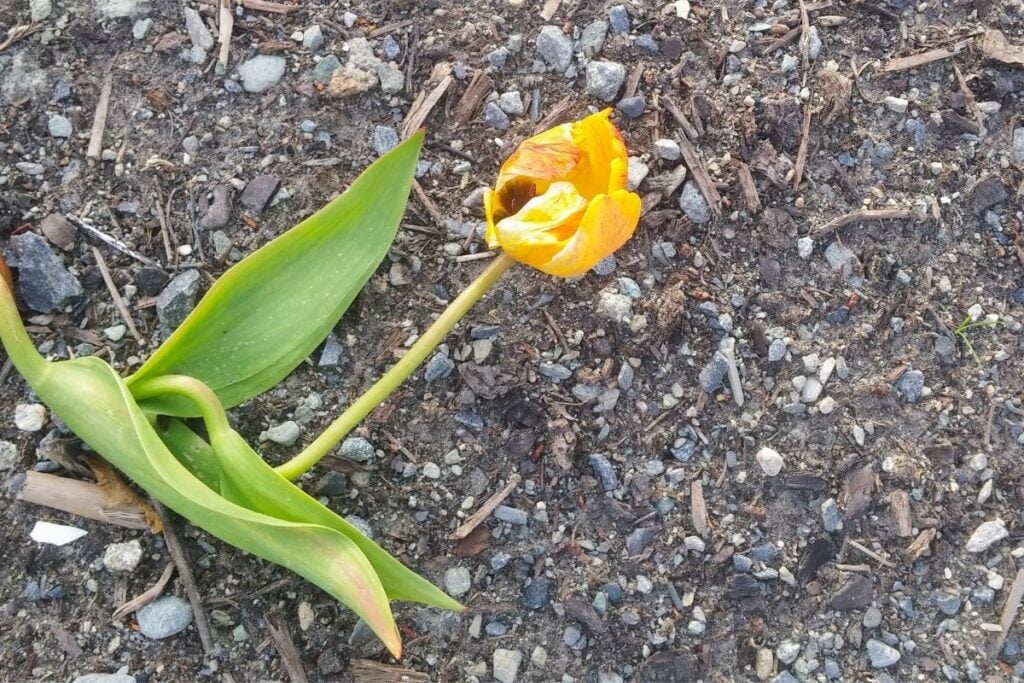
Why are the leaves of my tulips shriveling?
Shriveling of leaves can be caused by various reasons. The most common factors are water, light, fertilizer, and temperature.
You should look after your tulips regularly to identify what’s wrong with them on time. Because of improper care, tulips find it challenging to stay healthy, showing sickness symptoms.
To treat your shriveled tulips, you need to find out the exact problem they might face. You need to analyze specific problems and provide them with the essential requirements.
Let’s discuss each of the causes in detail with the respective solutions.
Improper watering
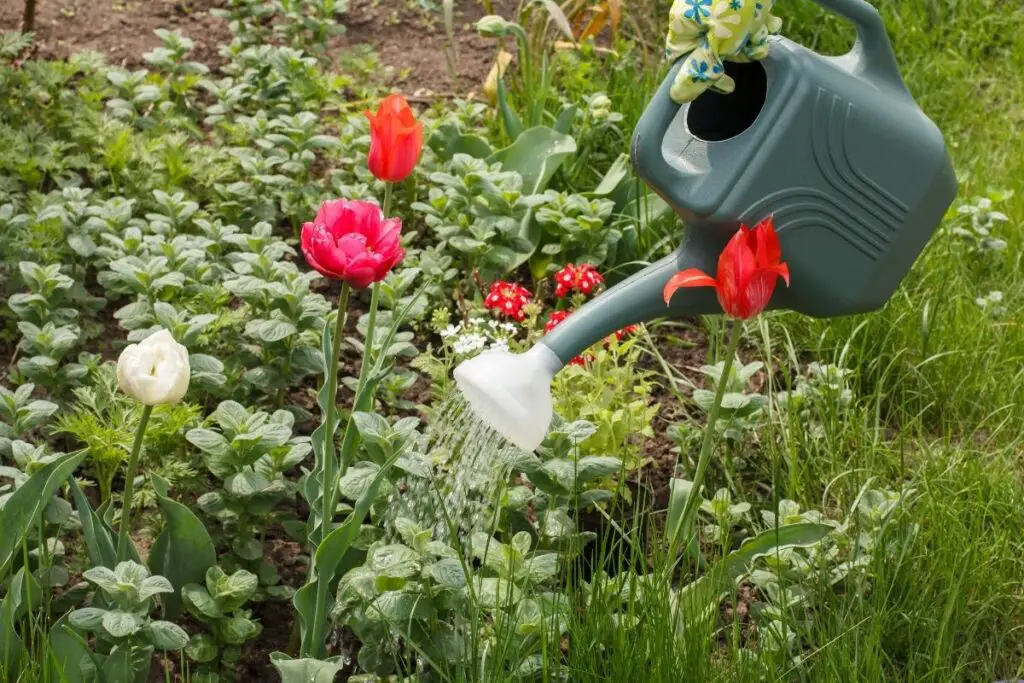
Inappropriately watering your tulips can make them undergo several problems. Incorrect watering is a common mistake most gardeners make.
There are mainly two types of watering problems that are underwatering and overwatering.
In both cases, tulips can experience shriveling leaves. Tulips don’t need to be watered frequently, but most gardeners water them regularly, hampering their health.
Overwatering is most likely to occur in tulips as compared to underwatering. It mostly happens because of poor draining soil and frequent watering.
Watering tulips once a week is enough for them to survive. When tulips are overwatered, the soil becomes soggy, due to which it becomes difficult for the roots to get Oxygen, and they start decaying.
When the roots get damaged because of waterlogging, it becomes difficult for the plant to absorb water and nutrients and become weak.
Due to a lack of water and nutrients, the leaves of tulips start to shrivel.
Similarly, underwatering can also cause shriveling of the tulip leaves.
As water helps to carry out nutrients from the soil to the various plant cells for getting energy, underwatering will make your plant weak as they won’t get the energy to function correctly, and they begin to curl their leaves and shrivel.
The typical symptom is the browning of leaves at the edges and tips in both cases. You can solve the problem quickly without getting worried.
Solution
Water your plant only if it is required. Always check the soil’s moisture before watering.
You need to ensure the soil holds enough moisture without getting soggy. After watering, wait until the soil is arid. As tulips only need water once a week, wait at least for 5 to 6 days and then water your plant.
To recover them from overwatering, provide your tulips with a whole day of direct sunlight or transplant them into a new location by removing damaged roots.
To solve the problem of under watering, water them regularly until the tulip gets normal and healthy to adapt to the regular watering schedule.
Check the soil moisture frequently by using your finger to avoid the issues related to watering.
Also read: How Often Do Tulips Need To Be Watered? (Tulip Watering Needs )
Looking for gardening supplies? We have tested 100's of products before recommending them to you guys. Check out our best pick below:
| Image | Gardening Supplies | Best Price? |
|---|---|---|
 Top
Top Top
Top | Raised Garden Bed Kit | Check On Amazon |
 | XLUX Soil Moisture Meter, Plant Water Monitor, Soil Hygrometer Sensor for Gardening, Farming, Indoor and Outdoor Plants, No Batteries Required | No Results |
 Top
Top Top
Top | 82 Pcs Garden Tools Set and Extra Succulent Tools Set | Check On Amazon |
 | Joeys Garden Expandable Garden Hose with 8 Function Hose Nozzle, Lightweight Anti-Kink Flexible Garden Hoses, Extra Strength Fabric with Double Latex Core, (50 FT, Black) | No Results |
 Top
Top Top
Top | Dual Chamber Compost Tumbler | Check On Amazon |
 Top
Top Top
Top | Sunnyglade Plant Stakes | Check On Amazon |
 Top
Top Top
Top | Organic Cold Pressed Neem Seed Oil | Check On Amazon |
 Top
Top Top
Top | Mighty Mint Gallon :-Insect and Pest Control Peppermint Oil | Check On Amazon |
 Top
Top Top
Top | Scotts DiseaseEx Lawn Fungicide | Check On Amazon |
 Top
Top Top
Top | Jacks Classic 20-20-20 All Purpose Fertilizer | Check On Amazon |
 Top
Top Top
Top | 30,000 Seeds Pollinator Attracting Wildflower Mixture | Check On Amazon |
 Top
Top Top
Top | Survival Vegetable Seeds Garden Kit-Over 16,000 Seeds | Check On Amazon |
Improper lighting

Tulips need at least 6 hours of direct sunlight every day to promote healthy growth. If tulips are not provided with a sufficient amount of light, then they can have shriveled leaves.
On the other hand, excessive sunlight can also cause the same problem. The proper amount of sunlight encourages plants to grow healthy as it provides energy.
If tulips fail to get enough direct sunlight, they will not get good energy for photosynthesis, due to which the leaves start to shrivel.
Sunlight is also responsible for the formation of chlorophyll. Without them, the leaves will start to lose their green color, which results in yellow curling of leaves.
Similarly, due to excessive sunlight, the leaves of a plant burns and cause shriveled leaves. Let us discuss how you can solve this problem.
Solution
If your tulips are not receiving enough direct sunlight, transplant them into a new location where they will get at least 6 to 7 hours of direct sunlight each day.
If there is any hurdle blocking the light, try to remove them.
If your tulips are receiving too much sunlight during hot weather conditions, try to provide shade to them so that your plant will not get sunburns.
Provide a sufficient amount of water to your tulips during the heat to recover them from shriveled leaves and sunburn.
Also read: How Much Sunlight Do Tulips Need? (Tulip Light Needs)
Excessive fertilization
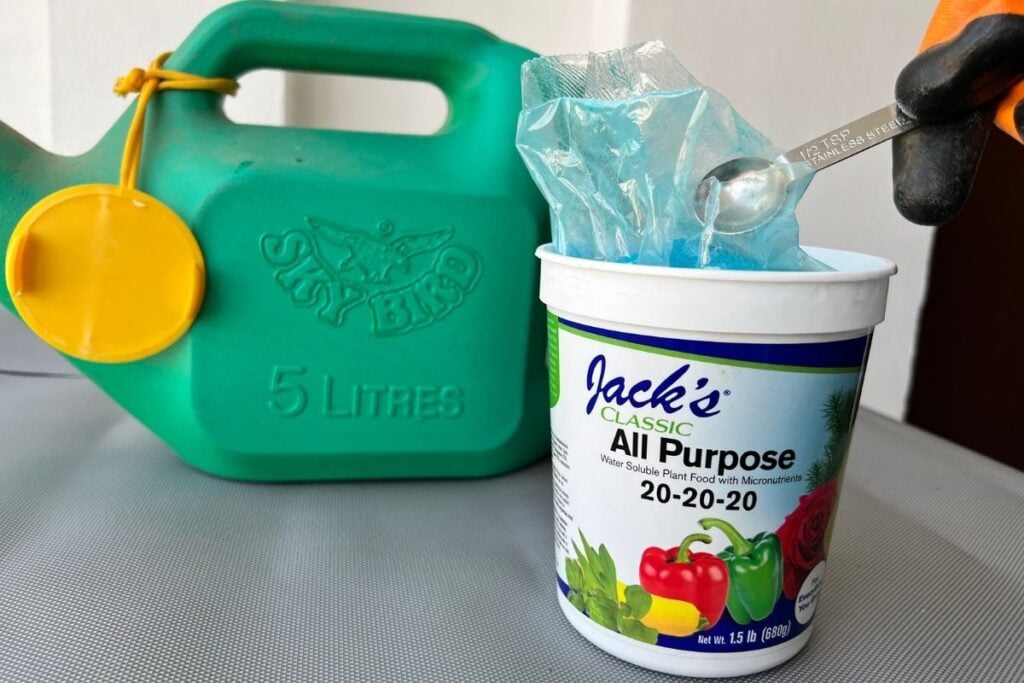
Overfertilization is one of the most common problems tulips can undergo. These plants do not need to be fertilized often.
Tulips can even survive without receiving any extra nutrients. They only need nutrients in a minimal amount.
Tulips need to be fertilized once a year with slow-release fertilizer, but most gardeners still make the mistake of fertilizing them frequently and in a substantial amount.
Fertilizers contain salts in a considerable amount. If these plants are over-fertilized by any chance, tulips face difficulty in absorbing water and minerals from the soil as the salts present in the soil have already absorbed water.
If tulips fail to receive water and minerals, they do not get any energy to function correctly, resulting in shriveling of leaves.
Solution
If you want to fertilize tulips, provide them with a slow-release fertilizer in the N-P-K ratio of 10:10:10 but make sure to apply a small dose. While fertilizing, you should apply a liquid method to avoid over-fertilization.
To remove excess fertilizer from the soil, scratch the top layer of the soil and cover it with the fresh new one. If the situation is out of control, replant tulips in a new location using the new organic soil.
Also read: What Is The Best Fertilizer For Tulips? (Organic+Inorganic)
Root rot
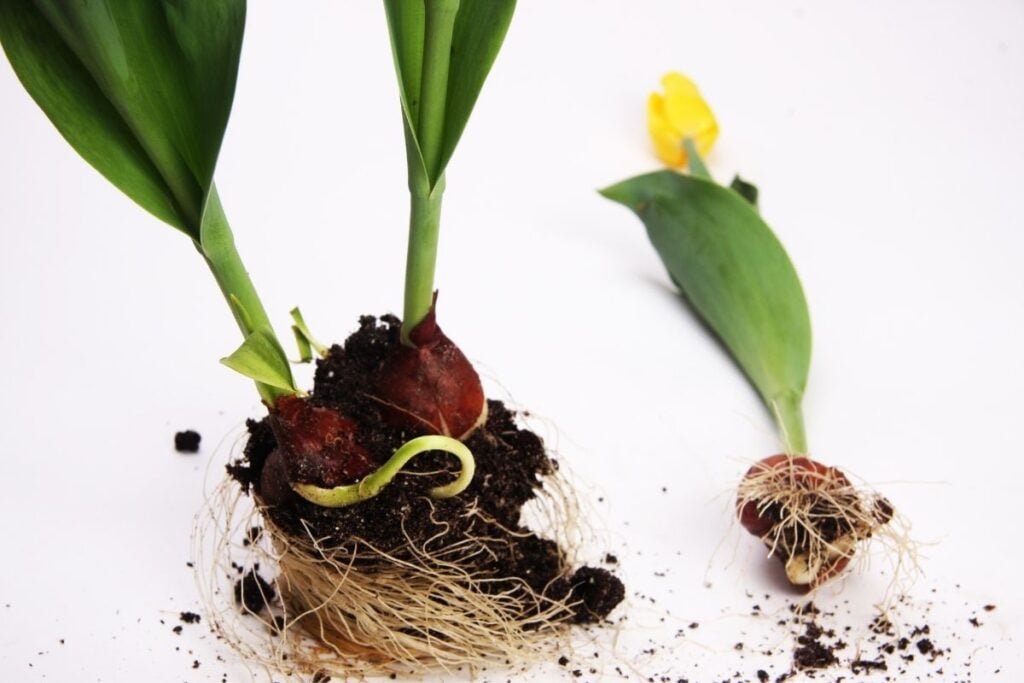
Plant health depends on their roots. If the roots are not healthy, it directly affects a plant’s growth. If the roots are damaged, leaves of tulips will droop, shrivel, wilt, and can even fall.
Root rot takes place because of overwatering. When the roots stay in the water for a more extended period, numerous kind of fungi infections starts to develop inside the soil and causes severe damage to the roots of a plant.
Because of several fungi infections and pathogens inside the soil, it becomes difficult for tulips to absorb nutrients from the roots, resulting in shriveled leaves.
Solution
As root rot happens because of overwatering, you need to make sure that you water your plant only when the soil is dry.
You can improve drainage by adding enough sand to the soil. Try to provide whole-day direct sunlight to your tulips to recover them from overwatering.
If the roots are damaged completely, transplant your tulips in a new location by pruning all the damaged roots and keeping only healthy ones. Make sure you don’t use the old soil while replanting it.
Also read: How To Save Overwatered Tulips? (Possible Signs, Causes & How To Fix)
Poor soil
Poor soil includes wrong pH levels, poor drainage, excess draining, or less nutrient content.
Tulips thrive in soil that is nutritious, well-draining and has a pH level of 6.0 to 7.0. Poor and fast-draining soil can create the problem of overwatering and underwatering, which can cause shriveling of leaves.
The wrong pH level of the soil can also create a massive problem in the health of tulips. The soil should be neutral, which means neither acidic nor alkaline.
Otherwise, tulips can suffer from many health issues and show symptoms like shriveling leaves.
Solution
Always use soil that has good drainage and can hold up enough moisture for a longer time at the same time. You can add organic matter, peat moss, and manure compost for improving soil drainage. It helps to improve the heavy texture of the soil.
Soil should be light and loose enough to provide aeration among the roots. Providing enough sand content can also improve the heavy texture of the soil.
To provide nutrients, you can mulch around the soil surface with organic compost or wood ashes but make sure you apply only a tiny amount.
Adding bone meal, eggshells, Epsom salt, coffee can also help provide nutrients to the soil.
Also read: What Kind Of Soil Is Good For Tulips? (Best Soil Mix)
Pest infestation
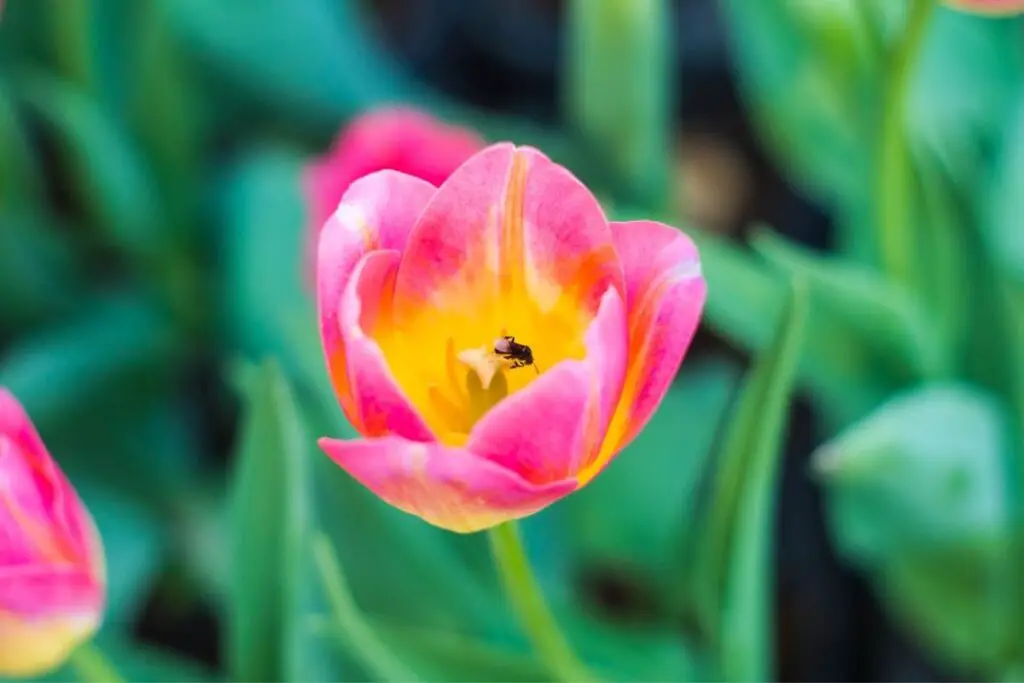
Numerous pests suck out the sap from the leaves and stems of a plant, leaving the plant weak and pale. Sap sucking pests include spider mites, aphids, mealybugs which cause severe injury to the entire plant.
When pests take out the sap from the leaves, tulips lose all the nutrients present in them, and it causes them severe weakness, and they end up curling and shriveling their leaves because of that.
If you see any pests have attacked your tulips, treat them as early as possible to avoid future troubles.
Solution
You can remove pests by washing them with a strong spray. While spraying, you can use neem oil, dish wash soap, or insecticidal soap.
Spraying them with a solution will help tulips get rid of pests and keep the plant healthy.
Make sure you don’t cause any injury to the plant while spraying, as tulips are sensitive plants.
While using dish wash soap, first spray the plant with it and wash them with normal water after spraying as it can damage the plant because of various substances present in it.
After washing your tulips, sanitize the area to prevent the pests from returning.
Also read: Bugs On Tulips: (Common Pests, Identification+How To Get Rid)
How to prevent shriveling of leaves?
You can recover your tulips from shriveling leaves quickly; you just have to care for their essential needs. For keeping them healthy, you need to take care of your tulips properly without ignoring their basic requirements.
Some preventive measures are given below to avoid shriveling leaves in tulips.
- Adequately water your tulips and make sure the soil has absorbed the water correctly without causing any excessiveness.
- Check the soil at regular intervals to determine whether your plant needs water or not to avoid the issue of underwatering and overwatering.
- After you have recovered the tulips from watering issues, stick to the regular water schedule of tulips that means water them once a week only after checking the moisture level.
- Tulips typically need a whole day of direct sunlight but avoid giving them direct sunlight during hot weather conditions and provide them shade.
- Fertilize tulips only when they need. You should fertilize them only once a year with a slow-release fertilizer.
- Be careful while transplanting them into a new location as it causes stress.
- While removing damaged roots, be careful and don’t harm the healthy ones.
- You can spray your tulips with horticulture oil every month so that the pests won’t come.
Final words
Taking proper care of your tulips will keep them healthy and won’t cause the shriveling of leaves. You should treat your plant gently and provide them with basic requirements to avoid such problems.
For treating them, you need to find out the exact problem they are suffering and solve them in a very gentle way without stressing your plant.
As soon as you notice shriveling of leaves in tulips, treat them immediately to avoid further problems in the future.
Source: Wikipedia, North Dakota Stae University, The Royal Horticultural Society.
